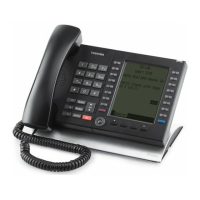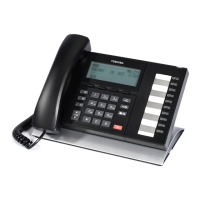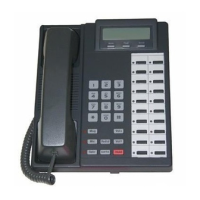Do you have a question about the Toshiba IP5631-SDL and is the answer not in the manual?
Lists trademarks relevant to the product and its components.
Details FCC compliance, radio frequency interference, and UL listing.
Discusses licensing requirements for music-on-hold features.
Explains FCC rules regarding hearing aid compatibility for business telephones.
Outlines warranty information for third-party products integrated with the VIPedge solution.
Describes the structure and organization of the guide, listing its chapters.
Lists related documents for the VIPedge solution, including general description and installation manuals.
General overview of the IP5x31-SDL telephone, its attributes, and button positioning.
Explains the function of fixed buttons on the dial pad for standard telephone operations.
Explains programmable feature buttons programmed by the system administrator for customization.
Defines Soft Keys (SK1-SK4) as dynamic buttons below the LCD that change functions based on the telephone's state.
Instructions for adjusting handset and speaker volume, ring tones, and beep tones.
How to adjust the LCD contrast on backlit telephones and add-on modules.
How to change the LCD backlight brightness for backlit telephones and add-on modules.
How to lower microphone sensitivity on IP5000-series telephones to improve call quality in noisy environments.
Describes three ways to originate a call: handset, speaker button, and hot dialing.
Details various methods for answering incoming calls, including handset, speaker, and shift button.
Describes actions that can be performed while on an active call, such as switching audio modes or placing calls on hold.
How to use the Msg LED/button and LCD to see and retrieve messages.
Explains account codes for billing, tracking, and line restriction, including forced and voluntary types.
How to set automatic callback when a station or line is busy, to be notified when it becomes idle.
Explains two types of call forwarding: System and Station Call Forwarding.
How the Call Park feature holds calls temporarily in orbits, allowing retrieval by orbit number.
How to pick up ringing or held calls from other stations or pickup groups.
How to transfer calls between telephones, including blind and supervised transfers.
How to conference up to eight parties, manage the master, and control conference calls.
How to activate and deactivate Do Not Disturb mode, affecting incoming calls and call forwarding.
How OCA enables completing calls to busy telephones automatically or after pressing a button.
Explains various override features like Busy Override, DND Override, and Executive Override.
Explains Speed Dial (SD) for dialing sequences with shorter codes, including System SD and Station SD.
Overview of the Call Manager user interface, including buttons, displays, and indicators.
Explains the compact view of Call Manager, which uses minimal screen space but provides essential information.
Describes the expanded view of Call Manager for managing multiple calls and accessing features.
How to use KeyTips for keyboard navigation and Hot Keys for quick dialing and answering.
Explains the side window for Personal Call Handler and programmable buttons.
How to change the Call Manager display color scheme between Blue, Silver, or Black.
Settings to customize Call Manager's appearance and functionality, accessed via the Preferences tab.
Settings controlling Call Manager's interaction with Windows programs and call handling reactions.
Settings to determine dialing plan adherence, server-based or local, and trunk access codes.
How Call Manager integrates with Microsoft Outlook for contact management and screen pops.
Settings for screen docking, including enabling docking, redocking on startup, and configuring used elements.
Settings for Call Manager connection, TAPI service provider, and diagnostic logging.
How to set up global "Hot Keys" for dialing from any application and bringing Call Manager to the front.
How to access and use programmable buttons, including the three methods to access them.
How Call Manager has programmable keys configurable as Feature, Speed Dial, User Action, etc.
How to create a speed dial key for one-button dialing, including trunk access code and pauses.
How to use System/PBX command keys and recommends creating User Defined Actions for them.
How DSS Extension Keys provide one-button dialing and status indication for a station.
How Web Keys program an Internet or Intranet URL into a key to open a specified web page.
How to set a key to run a specific application or load a specific document.
How to define powerful actions for Personal Call Handler and Programmable Keys, with testing facilities.
How to lookup phone numbers in Microsoft Outlook to open contacts or create journal entries.
How to change caller ID name, number, or account code of an active call.
How to send a URL to the PC's default web browser or open a companion application.
How to send a DDE Execute message to another program, often for contact management screen pops.
How to send keystrokes to another Windows program, useful for automating tasks or responding to calls.
How to change the Call Forwarding setting of the phone in the PBX for different forwarding types and destinations.
How to export actions for backup and copying to other Call Managers.
How to test actions using the Show Test/Hide Test button and set test values for variables.
How to create Call Handling Rules to automatically take actions based on events and conditions.
How to edit, delete, or add new rules, determining rule order and enabling/disabling rules.
How to select triggering events like Call Ringing, Call Answered, and set conditions like Caller ID, Extra Info, or Account Code.
How to design rules using specific numbers or names, with wildcard characters for pattern matching.
How to apply user-defined actions to a Personal Call Handling Rule, setting immediate or delayed actions.
How to export rules for backup and copying to other Call Managers, creating .RUI files.
How to dial contacts from Outlook using the Outlook Phone Link feature.
How to set up rules to automatically run Outlook lookup actions for incoming calls.
How to put appointment information on DSS keys to show presence status based on Outlook Calendar.
How to create actions to set and clear DSS messages based on Outlook calendar appointments.
Overview of the Contacts application, including directories, presence status, and speed dial.
List of names and extensions on the telephone system, with options to call, drag/drop, or filter entries.
List of telephone numbers for fast access, with options to call, edit, lookup in Outlook, or export.
How to view presence status of group members integrated within the Contacts application.
How Call Manager automatically logs calls dialed and received, providing a log of phone calls.
How the Call Manager Chat program allows interactive chat conversations with other users.
Primary function of Call Manager Chat is to place and receive chat calls and conduct conversations.
How the Dialer allows scheduling phone calls and displays call status.
How to view or change Dialer configuration settings like Do-Not-Disturb call placement and delay between calls.
How Call Manager provides an integrated web browser for accessing Internet or Intranet locations.
User level assignment, login path/URL, and security code (password) from the System Administrator.
Steps to log in to Enterprise Manager using Microsoft Internet Explorer and user credentials.
Functions available on the Home screen, including setting ringing patterns, assigning keys, and managing DND.
How feature key or button assignments are labeled and coded to represent functions.
Screen sections for CF Internal Calls/Line Calls and CF Direct Line Calls, explaining forwarding options.
How to enable Station Speed Dial, with a maximum of 100 numbers per station.
How to modify Voice Mail settings, including message waiting light, time zones, password, and call screening.
Functions performed on the Preferences screen, including display language, color scheme, and password entry.
Index entries for topics starting with A through C.
Index entries for topics starting with D through K.
Index entries for topics starting with L through R.
Index entries for topics starting with S through W.
Lists trademarks relevant to the product and its components.
Details FCC compliance, radio frequency interference, and UL listing.
Discusses licensing requirements for music-on-hold features.
Explains FCC rules regarding hearing aid compatibility for business telephones.
Outlines warranty information for third-party products integrated with the VIPedge solution.
Describes the structure and organization of the guide, listing its chapters.
Lists related documents for the VIPedge solution, including general description and installation manuals.
General overview of the IP5x31-SDL telephone, its attributes, and button positioning.
Explains the function of fixed buttons on the dial pad for standard telephone operations.
Explains programmable feature buttons programmed by the system administrator for customization.
Defines Soft Keys (SK1-SK4) as dynamic buttons below the LCD that change functions based on the telephone's state.
Instructions for adjusting handset and speaker volume, ring tones, and beep tones.
How to adjust the LCD contrast on backlit telephones and add-on modules.
How to change the LCD backlight brightness for backlit telephones and add-on modules.
How to lower microphone sensitivity on IP5000-series telephones to improve call quality in noisy environments.
Describes three ways to originate a call: handset, speaker button, and hot dialing.
Details various methods for answering incoming calls, including handset, speaker, and shift button.
Describes actions that can be performed while on an active call, such as switching audio modes or placing calls on hold.
How to use the Msg LED/button and LCD to see and retrieve messages.
Explains account codes for billing, tracking, and line restriction, including forced and voluntary types.
How to set automatic callback when a station or line is busy, to be notified when it becomes idle.
Explains two types of call forwarding: System and Station Call Forwarding.
How the Call Park feature holds calls temporarily in orbits, allowing retrieval by orbit number.
How to pick up ringing or held calls from other stations or pickup groups.
How to transfer calls between telephones, including blind and supervised transfers.
How to conference up to eight parties, manage the master, and control conference calls.
How to activate and deactivate Do Not Disturb mode, affecting incoming calls and call forwarding.
How OCA enables completing calls to busy telephones automatically or after pressing a button.
Explains various override features like Busy Override, DND Override, and Executive Override.
Explains Speed Dial (SD) for dialing sequences with shorter codes, including System SD and Station SD.
Overview of the Call Manager user interface, including buttons, displays, and indicators.
Explains the compact view of Call Manager, which uses minimal screen space but provides essential information.
Describes the expanded view of Call Manager for managing multiple calls and accessing features.
How to use KeyTips for keyboard navigation and Hot Keys for quick dialing and answering.
Explains the side window for Personal Call Handler and programmable buttons.
How to change the Call Manager display color scheme between Blue, Silver, or Black.
Settings to customize Call Manager's appearance and functionality, accessed via the Preferences tab.
Settings controlling Call Manager's interaction with Windows programs and call handling reactions.
Settings to determine dialing plan adherence, server-based or local, and trunk access codes.
How Call Manager integrates with Microsoft Outlook for contact management and screen pops.
Settings for screen docking, including enabling docking, redocking on startup, and configuring used elements.
Settings for Call Manager connection, TAPI service provider, and diagnostic logging.
How to set up global "Hot Keys" for dialing from any application and bringing Call Manager to the front.
How to access and use programmable buttons, including the three methods to access them.
How Call Manager has programmable keys configurable as Feature, Speed Dial, User Action, etc.
How to create a speed dial key for one-button dialing, including trunk access code and pauses.
How to use System/PBX command keys and recommends creating User Defined Actions for them.
How DSS Extension Keys provide one-button dialing and status indication for a station.
How Web Keys program an Internet or Intranet URL into a key to open a specified web page.
How to set a key to run a specific application or load a specific document.
How to define powerful actions for Personal Call Handler and Programmable Keys, with testing facilities.
How to lookup phone numbers in Microsoft Outlook to open contacts or create journal entries.
How to change caller ID name, number, or account code of an active call.
How to send a URL to the PC's default web browser or open a companion application.
How to send a DDE Execute message to another program, often for contact management screen pops.
How to send keystrokes to another Windows program, useful for automating tasks or responding to calls.
How to change the Call Forwarding setting of the phone in the PBX for different forwarding types and destinations.
How to export actions for backup and copying to other Call Managers.
How to test actions using the Show Test/Hide Test button and set test values for variables.
How to create Call Handling Rules to automatically take actions based on events and conditions.
How to edit, delete, or add new rules, determining rule order and enabling/disabling rules.
How to select triggering events like Call Ringing, Call Answered, and set conditions like Caller ID, Extra Info, or Account Code.
How to design rules using specific numbers or names, with wildcard characters for pattern matching.
How to apply user-defined actions to a Personal Call Handling Rule, setting immediate or delayed actions.
How to export rules for backup and copying to other Call Managers, creating .RUI files.
How to dial contacts from Outlook using the Outlook Phone Link feature.
How to set up rules to automatically run Outlook lookup actions for incoming calls.
How to put appointment information on DSS keys to show presence status based on Outlook Calendar.
How to create actions to set and clear DSS messages based on Outlook calendar appointments.
Overview of the Contacts application, including directories, presence status, and speed dial.
List of names and extensions on the telephone system, with options to call, drag/drop, or filter entries.
List of telephone numbers for fast access, with options to call, edit, lookup in Outlook, or export.
How to view presence status of group members integrated within the Contacts application.
How Call Manager automatically logs calls dialed and received, providing a log of phone calls.
How the Call Manager Chat program allows interactive chat conversations with other users.
Primary function of Call Manager Chat is to place and receive chat calls and conduct conversations.
How the Dialer allows scheduling phone calls and displays call status.
How to view or change Dialer configuration settings like Do-Not-Disturb call placement and delay between calls.
How Call Manager provides an integrated web browser for accessing Internet or Intranet locations.
User level assignment, login path/URL, and security code (password) from the System Administrator.
Steps to log in to Enterprise Manager using Microsoft Internet Explorer and user credentials.
Functions available on the Home screen, including setting ringing patterns, assigning keys, and managing DND.
How feature key or button assignments are labeled and coded to represent functions.
Screen sections for CF Internal Calls/Line Calls and CF Direct Line Calls, explaining forwarding options.
How to enable Station Speed Dial, with a maximum of 100 numbers per station.
How to modify Voice Mail settings, including message waiting light, time zones, password, and call screening.
Functions performed on the Preferences screen, including display language, color scheme, and password entry.
Index entries for topics starting with A through C.
Index entries for topics starting with D through K.
Index entries for topics starting with L through R.
Index entries for topics starting with S through W.











